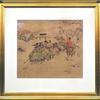The painting is behind glass, framed in a passe-partout.
This painting has a certificate confirming its authenticity issued by DESA Dzieła Sztuki i Antyki Sp. z o. o.
This painting was created in 1942. This watercolor was painted by Karol Kossak during his several-year stay in the Hutsul region at the turn of the 1930s and 1940s. It shows a winter scene with a horse motif typical of that period. During this period, the artist experienced great fascination with the Hutsul region and the landscape of the Eastern Carpathians with characteristic Orthodox churches, huts and crosses, painting beautiful watercolors with subtle colors.
In the foreground there are three pairs of Hutsul horses and three Hutsuls walking through a ravine covered with snow. The group heads up a fairly steep hill; it was captured by the artist while heading towards the farmsteads. Two horses in the front - a gray one and a chestnut one - are pulling a loaded sleigh. The second pair shows a piebald horse and a black horse, on which a Hutsul is sitting with a whip in his hand. Behind the first sleigh is a third pair of horses without a sled - a gray and a bay, ridden by a second man in a characteristic Hutsul costume - a red sheepskin coat and a cap. The third man follows the teams on foot. The horses' physiognomy shows signs of fatigue from the hardships of the journey. In the distance there is a typical winter rural landscape, with typical Hutsul huts and a well, which are covered with a thick layer of fresh snow. On the right you can see the snow-covered edge of the forest. The artist beautifully presented a scene from the life of a Hutsul village, skillfully and subtly conveying its idyllic, winter mood.
Detailed biography:
Karol Kossak (born May 2, 1896 in Lviv, died 1975 in Ciechocinek) - Polish painter, illustrator. Karol, coming from the famous Kossak family, was the grandson of Juliusz and the son of Stefan. His uncle was the battle painter Wojciech Kossak, the father of the poet Maria Pawlikowska-Jasnorzewska, the writer Magdalena Samozwoniec and Jerzy Kossak, who belonged to the third generation of painters in the family. Karol Kossak was born in Lviv in 1896. He studied drawing with Stanisław Batowski and Zygmunt Rozwadowski. Initially, he studied in Vienna, and after World War I, he continued his studies at the Academy of Fine Arts in Kraków. His uncle Wojciech also gave him lessons in "Kossakówka". For many years he taught drawing at the 9th Junior High School in Lviv. In 1927, he married Antonina Wanda Czerkawska and moved to her estate in Dziedziałów. In 1954, his only daughter Teresa was born. The Kossak family moved to Tatarow nad Prutem, where they built their own house. Karol Kossak, enchanted by Hutsul folklore and the landscape of the Carpathians with characteristic Orthodox churches, huts and crosses, paints watercolors with subtle colors. He also draws horses, equaling his grandfather's skill in delicate drawing. He illustrates the book of his cousin Zofia Kossak - Szczucka "The Adventures of Kacperek, the Górecki Dwarf", dealing with fantastic themes. He exhibited his works several times at the Society of Fine Arts in Lviv. He also published a series of postcards in the Atlas Library in Lviv - reproductions of his watercolors on Hutsul themes. During the war, he drew in a drawer, documenting the events he witnessed. The house in Tatarów burned down and the Kossaks began their wandering. Through Stanisławów, Jasło, Bączala, Swięcany, Siepietnica near Gorlice they reached Bieździedza near Kołaczyce. Finally, they settled in Ciechocinek. In 1948, the Kossaks moved into a wooden house at ul. Traugutta opposite the Spa Park, with windows overlooking the mineral water pump room. Karol Kossak became a famous figure in Ciechocinek. He was liked and made many friends, which is not surprising, because he was an optimistic, kind man with a sense of humor. He was open to people and understanding. He had acting talent. The artist drew a lot with pen and pencil. He left a lot of watercolors with depictions of horses. There are also interesting scenes from the patients' lives. He was extremely hard-working and systematic. As Stanisław Komornicki writes, he painted with iron consistency from nine to one, and outdoor work took him many hours every day. He painted until his last days - of course, his beloved horses. He repeatedly participated in collective exhibitions of the Bydgoszcz District of the Association of Polish Artists, of which he was a member. Despite frequent offers, he did not agree to a retrospective solo exhibition because he was aware that only a fragment of his achievements had survived. In Ciechocinek you can see his paintings at Primary School No. 1. Marshal Józef Piłsudski, at the City Hall and at the post office, where, thanks to Mrs. Maria Krowińska, you can read information about the artist's life and work. On the centenary of his birth in 1996, a one-day exhibition of Karol Kossak's paintings was opened in the mineral water pump room, which included works borrowed from the residents of Ciechocinek. Over forty of them gathered. The highlight of the celebration of the painter's birth anniversary was the unveiling by the artist's daughter, Teresa Kossak, of a plaque placed on the front of the house where her father lived and painted for 27 years. The painter's ghost walks the streets of Ciechocinek. An elegant man in a hat and with a walking stick walks near the Spa Park.




